Latinx History in Fort Collins#
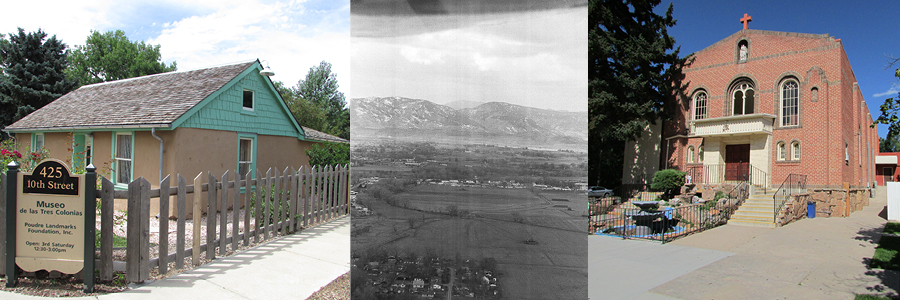
Left: Romero House, 425 10th Street; Center: 1968 aerial image of Alta Vista at bottom/fore, looking west (C01638, Courtesy of the Fort Collins Museum of Discovery); Right: Holy Family Catholic Church, 326 N. Whitcomb Street.
A Note on Terminology
The information below frequently uses the gender-inclusive term “Latinx” to refer to residents of the city who trace their roots to Latin America. However, the term Hispanic has been used as well as a recognized term in the United States for a similar cross-section of people. Prior to the 1950s, the vast majority of Latinx residents in Fort Collins were Hispanic families who moved here from northern New Mexico and Texas as well as Mexican nationals who lived and worked here seasonally or immigrated to become permanent residents, as noted below. After the 1950s, due to larger international trends in immigration to the United States, the Latinx community in Fort Collins evolved into an increasingly diverse group of residents with roots in other nations in Central and South America and the Caribbean, as well as the U.S. Territory of Puerto Rico.
Want to Explore Places in the Latinx History of Fort Collins? Try this Virtual Tour!
Explore some selected sites important to Latinx/Hispanic heritage in Fort Collins on foot, by bike, or by car.
Latinx Americans in Colorado#
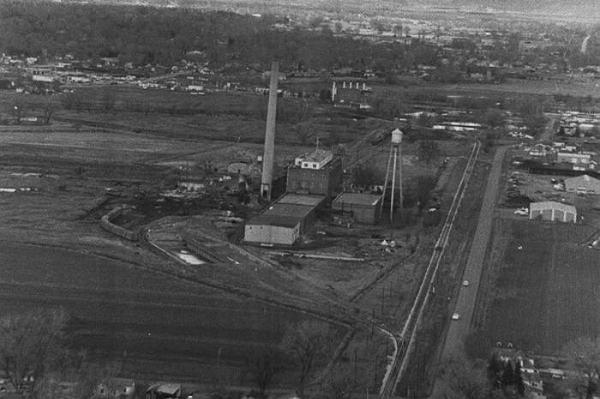
The Great Western Sugar Factory on Vine Drive, looking west. (C01637, Courtesy of Fort Collins Museum of Discovery)
European settlement in the territory of indigenous communities, in the region now known as the American West, was initiated by Spanish explorers, conquistadors, and Catholic clergy beginning in the 1500s. By the 1700s, Spanish settlements and missionswere established in present-day California, Arizona, New Mexico, Texas, and southern Colorado, particularly along the coasts and waterways of those areas. In what is now Colorado (then northern New Mexico), Spanish families settled along the upper Rio Grande River and formed the territory of San Luis, now known as the San Luis Valley. The Arkansas River and the Front Range generally formed the northern and eastern extents of Spanish interests, with territory north and east of that becoming part of French Louisiana by the 1700s. The native Comanche and Pawnee people of southern Colorado resisted colonization through ongoing conflict and warfare with the Spaniards. After the United States purchased Louisiana from France in 1803, Anglo-American influence came from the north and east. When the Treaty of Guadalupe Hidalgo ended the Mexican-American War between the newly independent Mexico and the United States in 1848, Mexico ceded most of what was then the northern third of the country. Present-day Colorado became American territory, and most Mexican residents in the ceded lands chose to remain and become American citizens, making Mexican Americans a significant ethnic group in the United States since before the Civil War.
The Latinx experiences in western regions like Colorado and the Front Range are complex, especially after 1848, as both Mexican Americans and Mexican immigrants maintained their cultural identity and traditions in a land increasingly dominated by predominately Anglo-American settlements, and in which they experienced increasing discrimination from their new neighbors. By the mid-twentieth century, Latinx people from other parts of the world, including Central and South American and the Caribbean, began migrating to Colorado as part of a more diverse Latinx diaspora across the United States. Their story is one of long-term community-building, perseverance, and resistance against systemic racism—a theme that is reflected in Latinx history across the United States, including western communities such as Fort Collins.
Hang Your Wagon to a Star: Hispanics in Fort Collins
In 2003, the City commissioned an historic context report about Latinx/Hispanic history in Fort Collins, with emphasis on the history of Mexican American sugar beet workers in Fort Collins since about 1900. Authored by Adam Thomas, now an history professor at Colorado State University, the report includes much about the early history of Latinx Americans in Fort Collins, and their lives and contributions to the city's history.
Sugar Beet Workers: Early Mexican American Families in Fort Collins#
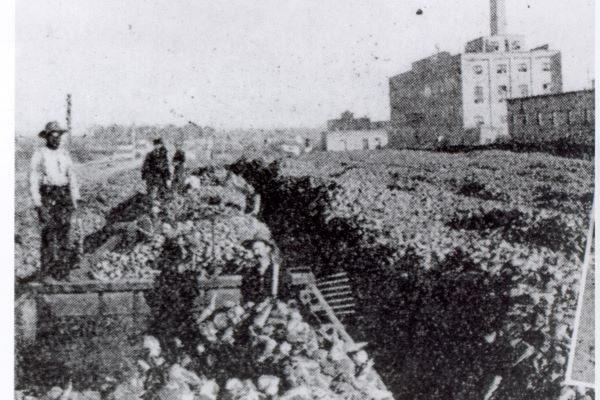
Hispanic sugar beet workers with the Great Western Sugar Factory in the background. (H03125, Courtesy of the Fort Collins Museum of Discovery)
The early history of Latinx settlement in Fort Collins was closely tied to farming and ranching. Mariana Modena is known as the first European settler in Larimer County. In 1858, Modena moved his family to the Big Thompson River Valley to what is now the Loveland area in southern Larimer County. Other Hispanic families joined him and took advantage of the Homestead Act after its passage in 1862 to solidify land claims. Among the early arrivals to the Fort Collins area was José de Jesús Aragón and his family who arrived in Fort Collins with a group from New Mexico. Over the late-1800s and early-1900s, more Mexican Americans and new immigrants from Mexico lived as seasonal labors or as new settlers in the Fort Collins area, where they worked on farms, ranches, on railroad crews, in sandstone and limestone quarries, and in the sugar beet industry. By the 1900s, the Mexican American community was well-established with many businesses owned by, or catering to, the needs of these residents.
However, between 1910 and 1930, factors in both northern Colorado and in Mexico and the southwest United States compelled more Latinx families to move to Fort Collins. A civil war in Mexico, known as the Mexican Revolution, between 1911-1920 destabilized the country and compelled many Mexican families to move north to the United States. Jobs in the United States, frequently in agriculture and manufacturing, provided the hope of a more peaceful and prosperous life. Nearly a tenth of Mexico’s total population migrated to the United States during this period. Those that chose Fort Collins were drawn by available jobs for, and active recruitment by, the agricultural industry that was booming in northern Colorado at the time. One of the significant recruiters of Mexican Americans to Fort Collins was the Great Western Sugar Company which had purchased the beet sugar factory on East Vine Drive in 1904. Many Mexican families initially found work in the factory’s limestone operation at Ingleside, which became a sizeable lime quarrying facility for Great Western Sugar that supplied processing lime for most of the company’s operations throughout the west. As the community grew, they found jobs working at the factory itself and on the sugar beet in the region farms that supplied Great Western Sugar. Other families worked on area farms that were growing livestock or produce for the surrounding region. Fort Collins’ beet sugar industry had relied on labor from the ethnic Germans from Russia for most of the first decade of production, but the First World War cut off immigration from Europe, and the ethnic Germans moved on to less intensive and better paying work. This led to a labor shortage that Mexican immigrants filled. Approximately ninety percent of new migratory laborers Great Western Sugar brought to Larimer and Weld Counties between 1910-1930 were from Mexico.
Early Latinx residents in Fort Collins were largely single men working as migrants on area farms and staying in farm shanties, bunkhouses, or hotels and boarding houses in town. However, as Mexican immigrants became a dominant source of labor for Great Western Sugar in the late-1910s, whole families moved to the area. The sugar beet work itself was intense, as sugar beet farming relied on hand laborers well into the 1950s, despite advances in agricultural equipment and technology. Similar to the Germans from Russia before them, Mexican families that relocated to Fort Collins to work in the sugar beet industry adapted to an economic system designed to exploit cheap immigrant labor. In order to keep the beet sugar industry profitable, companies like Great Western Sugar paid farmers to grow beets – farmers who typically relied on contract labor at per-acre prices. To make a living wage, most laborers would commit to tending more acres of beets than they could possibly work themselves. This often meant that full families, including children, were expected to work the fields alongside their parents. It also meant that farm laborers frequently were provided very simple dwellings in order to save on costs. Federal labor reports confirm that assumption, and Colorado’s child labor laws exempted agricultural work from the minimum age requirement.
The Great Depression after 1929 made the situation worse, with wages dropping despite comparatively strong Colorado sugar prices. Living conditions deteriorating along with them, often with multiple families living in small shacks and other homes in predominantly Mexican American neighborhoods or on farms. Lack of municipal infrastructure, lack of jobs, and lack of quality housing meant that conditions for many Mexican American families were miserable. The economic crisis and competition for dwindling jobs also created public pressure around the country for Hispanic workers to return to their countries or region or origin. The 1937 Sugar Act helped regulate the market and improve conditions for sugar industry workers, but for many Mexican American beet workers, conditions remained poor well into the 1950s due to racism and discrimination in both labor and education. The Bracero Program, a cooperative agreement between the United States and Mexico between 1942 and 1964, attempted to ensure an adequate supply of seasonal laborers for the agricultural industry in the United States. However, this also drove down wages in the agricultural industry, perpetuating a cycle of poverty for many Hispanic workers across the country, including in Fort Collins. As the Great Western Sugar plant in Fort Collins scaled back and closed in 1955, many Latinx workers shifted to other agricultural and industrial work, service work, or joining the construction crews on the Colorado-Big Thompson Project, a massive project to divert Colorado River water to the Colorado Front Range, initiated in 1947 and lasting into the 1950s.
Mexican American Neighborhoods: Holy Family & Tres Colonias#
Amid the struggle to earn a living and find housing, the influx of Hispanic families to Fort Collins after 1910 meant that these families began establishing unique neighborhoods that reflected their own particular culture, partially from a desire to build community with others of similar backgrounds, and partially from discrimination from the community’s predominantly Anglo population. In 1923, in an effort to secure year-round labor, Great Western Sugar announced plans for a “Spanish Colony” northeast of their Fort Collins factory where it would sell 50-by-85-foot houses to Mexican American families on an installment plan over five years. The company hired Felipe and Pedro Arellano of northern New Mexico to build six, two-room model adobe structures, after which many families in the neighborhood built adobe structures of their own following the same building plans. Residents began referring to the neighborhood as “la Colonia Española,” known today as Alta Vista. The neighborhood, along with its earlier counterparts of Buckingham and Andersonville, remained on the east side of the Poudre River, keeping laborers within walking distance of the company factory and beet fields, but also designed with the intent of segregating foreign-born families from Anglo-American neighborhoods west of the river.
However, the number of Mexican American immigrants moving to the city meant that the three sugar factory neighborhoods were simply too small to accommodate the influx of new residents. An eighteen square block area bordered roughly by Elm Street on the north, Howes Street to the east, Laporte Avenue to the south, and Shields Street to the west, became a reservoir of housing for many Hispanic families. The larger neighborhood, comprised of components of the original 1873 Avery town plat, the West Side addition, and the Capitol Hill addition, was primarily built up in the 1900s as a working class neighborhood. While some of the first residents were Anglo and African American, the neighborhood quickly transitioned to primarily Mexican as it built out in the 1900s-1920s, being solidly Latinx by 1930. The neighborhood became the residence of successful Mexican American families that could afford to move out of the Tres Colonias neighborhoods and buy or rent a larger house near downtown Fort Collins. This area became anchored by the Holy Family Catholic Church at Cherry and Whitcomb Streets, which served as a cultural, religious, and social institution for the neighborhood and larger Latinx community from its construction in 1929 to the present.
Aside from a desire to remain with familiar neighbors, the distinctiveness of Latinx neighborhoods in Fort Collins was a direct result of widespread racism in the city. The Ku Klux Klan, America’s most notorious white supremacist organization, had strong membership in Colorado during the early 1900s and sponsored recruitment rallies and other public events from Denver to Fort Collins, which set the stage for Klan member Clarence Morley’s election as Governor of Colorado from 1925 to 1927. Among their key targets during this period were immigrants and Catholics, which included the majority of Latinx Americans at the time.
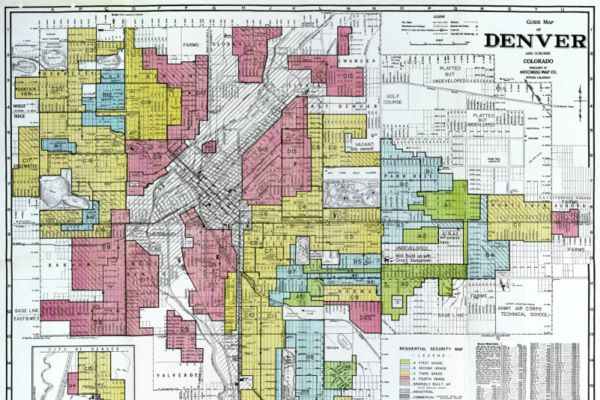
1938 Redlining map of Denver, Denver Public Library Western History & Genealogy Collection.
While the overt power of the Klan and other white supremacist organizations to control the levers of government declined in later years, discriminatory and racist practices endemic to American society continued. White property owners and landlords frequently discriminated against Hispanic (and Black) residents well into the 1960s through restrictive racial covenants that prevented purchase of property in many neighborhoods, and refusing to rent to non-white tenants. The problem was compounded by “redlining” neighborhoods to limit mortgage lending in non-white areas of cities. Both practices perpetuated racial segregation and the generational wealth gaps found today between white and non-white Americans. After the Second World War, the Colorado legislature passed a series of Civil Rights reforms including a 1948 ban on racially restrictive housing covenants, a 1951 act prohibiting racial discrimination in public employment, and a fair housing law in 1959. Although these laws were passed, their lackluster enforcement and implementation remained a key civil rights issue into the 1970s. Later U.S. Supreme Court case outlawed private-sector employment discrimination in Colorado in 1963 and forced an end to segregation in Denver Public Schools in 1973. Activism by Hispanic-led organizations like the United Farm Workers, United Mexican American Students, and others continued to fight for expanded equality and equity.
A Mexican American family in Fort Collins faced stark segregation in housing and discrimination in employment and services. Migrant workers on area sugar beet farms lived in poorly constructed shacks that were prone to fires, resulting in many deaths. Work in Great Western Sugar’s limestone quarry was dangerous, killing other workers including a notable explosion at Ingleside in 1908 that killed five Mexican American and three Japanese workers. Families often struggled to acquire or rent property outside of prescribed neighborhoods. Sometimes, local law enforcement enforced these intangible boundaries. Even the construction of Holy Family church in 1929 was a result of tensions in the primary Catholic church for the town, St. Joseph’s at the northwest corner of Howes Street and Mountain Avenue. The Mexican American contingent first established a small church in the former Westside Presbyterian Church building that used to stand on the northwest corner of Cherry and Whitcomb Streets. It later built the Holy Family Catholic Church due to the tiny church’s inability to host the hundreds of Fort Collins Latinx residents seeking Spanish-language services and community in a welcoming house of worship.
Racism against Mexican Americans was overt in the Fort Collins community. Many Anglo Americans in the city considered all Mexican American residents to be immigrants, despite the fact that many, especially early arrivals, were born in the United States and were from families that had lived in the American southwest since the 1600s. Throughout the first half of the twentieth century, discrimination in public places and businesses was a common practice. Businesses frequently placed signs in their windows reading “white trade only,” “no dogs or Mexicans allowed,” or “no Mexicans allowed.” Mexican American residents were usually barred from downtown lunch counters, had to sit in the balcony at movie theaters, and deferred to whites on city streets, similar to the Jim Crow laws that applied to Black Americans throughout the country at the time. Some stores notably refused these rules, including Nash’s Drug Store on Linden Street, but with the majority of businesses refusing service, accessing basic needs outside of their own neighborhoods and businesses was fraught for Mexican American families. In Tres Colonias, two stores, one in Andersonville and one at 100 E. 1st Street in Buckingham provided local alternatives free from the specter of segregation.
Educational discrimination was perhaps the worst, imposing multi-generational disparities in access to economic opportunity for Fort Collins’ Latinx families that is still experienced today. The economic advantage of having children working the sugar beet fields meant that they were not in school – a 1923 report showed that children of sugar beet contract workers were absent a quarter of the school year. Even when time allowed Mexican American children to go to school, the schools were often too far to walk to – Fort Collins schools were clustered near downtown in the early 1900s with limited transit options. In 1908, the school district built the Rockwood School in Andersonville to serve Germans from Russia, and later Mexican American, students which provided a nearby opportunity. However, high school remained in downtown Fort Collins, and after Rockwood closed in 19xx, the various elementary schools were simply too far away. Harassment and discrimination from white students and parents made the experience for Mexican American students who could attend classes difficult. The Catholic Church began offering classes out of Margaret Murray’s home at 315 N. Whitcomb Street in 1928, and later out of the church’s former wood-frame building after the 1929 brick church was built. Murray was soon assisted by Margaret Linden and Jovita Vallecillo, the first Mexican American graduate of Colorado Agricultural College (now Colorado State University). By 1934, they were teaching 85 students with four additional nuns as instructors. In 1948, the City condemned the school building and forced classes to move to the new parish hall south of the main church. However, lack of funding forced that school to close at the end of the 1968-1969 school year.
Environmental racism was prevalent as well, as Latinx neighborhoods were located close to sources of noise, air, and water pollution, including the Great Western Sugar factory, the Colorado & Southern Rail facilities on the northwest side of downtown, and the city dump which used to be located near the Light & Power Plant on North College Avenue, near the small Hispanic neighborhood along Linden Street north of downtown. While the City of Fort Collins annexed Buckingham in 1906, it provided limited public services, and did not annex the other two neighborhoods of Andersonville and Alta Vista until 1974. The City’s investments in public infrastructure made in wealthier, whiter neighborhoods did not extend to these neighborhoods. The sewer line did not reach Alta Vista until the early 1970s and street paving was delayed until 1980. The City had operated sewers south of the Poudre River since the 1880s and began paving streets south of the river in the 1920s.
As Latinx residents built community among themselves in spite of racism, they created a vibrant social life centered on largely Hispanic traditions. Holy Family Church remained the center of many of these events, including fiestas for various religious and cultural holidays, and quinceañeras for young family members. Among the largest celebrations were Cinco de Mayo, a celebration of the Mexican Army’s defeat of French forces on May 5, 1852, and Mexican Independence Day on September 16. Historically, the Independence Day celebration included a parade on College Avenue, speeches, bands, and other festivities and at one point was one of Colorado’s largest. Other holidays like el Dia de los Muertos on November 1 and the Feast of Our Lady Guadalupe on December 12 were also notable, if more somber, occasions throughout the year.
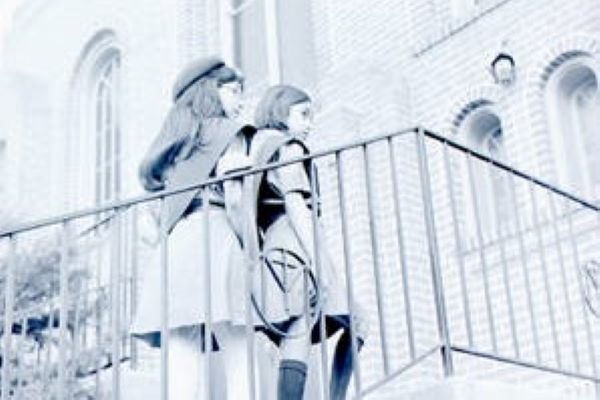
Girl Scouts at Holy Family Catholic Church, 1968. (H20855, Courtesy of the Fort Collins Museum of Discovery)
Baseball and softball proved to be a popular past time among residents of Fort Collins by the 1930s, which occasionally served as a means to bridge the stark racial divide between Hispanic and Anglo residents. Because minor league and semi-professional baseball was a low-cost endeavor, many of the players were working class regardless of race, and brought working class fans to their games. Predominantly Mexican American teams like the Rebels, Legionaries, and Merchants played at diamonds throughout the city and all around Northern Colorado and southern Wyoming, and sometimes contributed to improving the community’s parks that had baseball diamonds, including at City Park. Local merchants sponsored the teams to offset the costs for uniforms and travel. Some teams became semi-professional, forming the Rocky Mountain League in 1912. The teams themselves, and the crowds that watched them, steadily integrated as national trends in sports over the 1940s and 1950s broke down racial barriers. Baseball games in post-war Fort Collins became one of the few areas where white and Latinx neighbors came together with a mutual interest: to enjoy the game and helped promote community.
Fighting for Fairness: Advocacy in the Latinx Community#
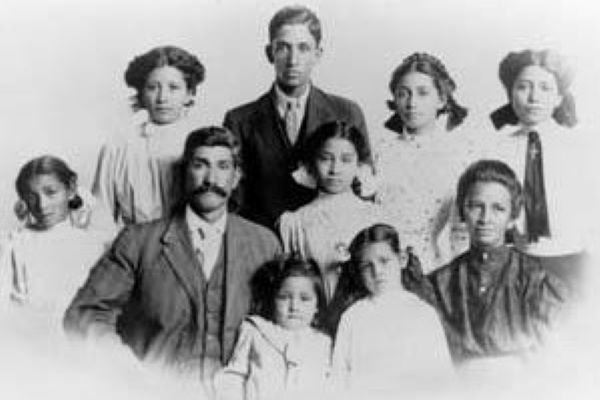
Lee Martinez with family in 1910 (Lee is in the back row, second from left). (H10817, Courtesy of the Fort Collins Museum of Discovery)
Improvements in these neighborhoods followed the efforts of leaders in the community like the Martinez and Romero families. With such a large influx of Mexican immigrants who were Spanish-only speakers, Mexican Americans like Lee Martinez and John and Inez Romero who were bilingual provided translation and notary services for those seeking assistance for financial, legal, and employment issues. Tres Colonias residents began organizing by the 1930s, electing unofficial mayors to handle local issues, since the city and county government largely ignored their needs. As early as 1927, the Spanish Catholic Young Men’s Association formed and began producing La Estrella, a local bilingual newspaper that only lasted a year. In 1932, the Robinson Printing Company published El Faro, another short-lived newspaper that supported labor organization among sugar beet workers. John Romero served on the Spanish-American rights committee, a group founded in 1934 to press local merchants to end discrimination and employers to offer jobs to younger Latinx residents. In 1941, the Alta Vista neighborhood elected Charlie Martinez as its mayor, who began organizing the neighborhood to take on certain public works maintenance that the city had ignored or neglected. sought economic and educational empowerment through their work at religious institutions and advocacy in the public forum. As early as the 1940s, farm laborers began unionizing in an effort to press for better pay and working conditions.
Holy Family Church became both a religious and social anchor for Latinx residents on both sides of the Poudre River, but it also took on social and economic justice issues on behalf of its congregation. Most notably, Father Juan Fullana became the pastor for the church between 1937 and 1950 and provided leadership in pressing for improvements for Latinx residents. In response to rampant discrimination in the community, Father Fullana established a store and entertainment venue in the church to serve Latinx residents. He opened a cooperative grocery store and often rented a local theater for Spanish-language screenings of films and operated a mop factory out of the basement of the church to help employ out-of-work residents. He left the church in 1950 and moved to Mexico; his life ended tragically there when he was murdered by thieves. In 1975, the neighborhood named its new elementary school Juan Fullana Elementary in his honor (now called the Fullana Learning Center).
While Holy Family remained the center of the Latinx community, other churches served the needs of the city’s Latinx residents as well. Both Westside and First Presbyterian Churches offered Spanish-language services. The Unitarian Church campaigned against “white trade only” signs in downtown businesses advertising business owners who sought to exclude Mexican Americans, Black Americans, and Native Americans from their establishments. Andersonville hosted a congregation of the Templo Betel Assembly of God, also known as the Spanish Assembly Church, built in 1960 and ministered by John and Orpha Vega starting around 1970.
After the Second World War, Latinx pressure for better working and living conditions became stronger. eventually leading to the formation of their own American Legion post at 9th and Vine Streets. The G.I. Bill for veterans helped many Latinx families begin accessing better housing and job opportunities that had not existed before. With better jobs and pay came more time to advocate and organize on behalf of the community. In the mid-1960s, Latinx residents formed a chapter of the League of United Latin American Citizens (LULAC) as a non-political entity but opened the door to more political action groups in the years that followed. Lee Martinez served on the City’s Human Relations Committee and he and John Romero actively sponsored voter registration drives to get Fort Collins’ Latinx residents to the polls.
However, younger activists pressed for more radical action to improve conditions. After 1965, Fort Collins area advocates joined with the national United Farm Workers union established by Cesar Chavez to improve working conditions and continue pressing for better access to community services. Students at Colorado State University formed the Mexican American Committee for Equality (MACE), which joined with the Black Student Alliance to pressure university officials to end discrimination both on and off campus. In the 1960s and 1970s as part of a larger national movement for Chicano civil rights, also referred to as El Movimiento, Fort Collins Chicano activists protested the harassment of Chicano men by the Fort Collins Police Department, frequently demonstrating in front of the police headquarters between the 1970s and 1990s.
This advocacy secured both concrete and symbolic commitments from the City and the school district. The earliest gain came in the form of education. The 1969 closure of the Holy Family parish school and the 19xx closure of the Rockwood School meant that the only elementary school facility for Latinx students was the deteriorated Laporte Avenue school. In 1969, thanks to door-to-door advocacy by Latinx leaders, a bond issue passed to provide funds for a new school in the Holy Family neighborhood. When the school board sought to re-allocate the funds for a new building in a new, white neighborhood in south Fort Collins, the advocates fought back hard. Leveraging the Mexican American Legal Defense Fund Association, and with representation from Frederico Peña, the future mayor of Denver, the neighborhood compelled the school board to reverse the decision. In 1975, the new school named in Father Juan Fullana’s honor was built on the former location of the LaPorte School, now known as the Fullana Learning Center. Despite the success, Latinx student drop-out rates remained high as making Latinx culture more visible and accepted in the school district and broader community has continued to be a challenge in the Poudre School District.
In the early 1980s, community advocates successfully halted a road-widening project on North Lemay that would have divided the Alta Vista and Andersonville neighborhoods. A new proposed bypass skirts the neighborhood and intended to move heavy traffic off the neighborhood streets near Alta Vista and Andersonville. In an important moment of symbolism in 1975-1976, local leaders renamed the streets of Tres Colonias from their former, simplistic lettered street names to names that recognized the history and leaders of the neighborhoods. In 1999, the City acquired the former John and Inez Romero house as a city park and museum to tell the story of Latinx history in the city.
Latinx Life at the University#
Colorado State University provided some opportunity for Latinx residents of the region to access a college education and the economic opportunities that came with it. However, their attendance at the University did not insulate Latinx students from the widespread discrimination against them in the community at large. Discrimination both on and off campus was endemic, with limited hiring of Latinx staff and professors, limited recruitment of Latinx students, and housing discrimination off-campus remaining persistent problems well into the 1970s. While Fort Collins never achieved the size for the Federal Housing Authority to officially “redline” the city (a process of identifying risk to lenders based on racial demographics), discrimination and segregation in housing nonetheless occurred. Latinx students frequently had difficulty finding housing off-campus. Two subdivisions platted in the 1940s (Circle Drive in 1945, and Slade Acres in 1948) barred non-whites other than domestic workers from owning property or living within their boundaries, even though such covenants became illegal in the state in 1948.
The persistence of discrimination motivated students to create the Mexican American Committee for Equality (MACE) in the late 1960s on campus. MACE worked with the Black Student Alliance (BSA) to pressure the University administration to address civil rights violations and support greater diversity on campus. This included combatting housing discrimination off-campus, but also recruiting more Latinx students, administrators, and faculty, to help make the university more representative of the state community it served. This pressure involved protests and sit-ins, often in partnership with BSA, including demonstrations on the lawn of CSU President William Morgan’s residence at 645 S. Shields Street on April 9, 1969, and demonstrations at the Lory Student Center and Old Main administrative building that month. The protests met with mixed success; the University began working on student demands focused on improved student recruitment and university hiring. The University established PROJECT GO in the 1960s thanks, in part, to advocacy by Vivan (Lee) Kerr, a member of the Black Student Alliance, to help incorporate the needs of ethnically-diverse and low-income students in an academic setting. While PROJECT GO started with Black students, it evolved into a program to support students from many backgrounds, including Latinx students. This eventually culminated in the creation of the Group Advocacy Program in 1979, an umbrella under which the University established student service organizations for Chicano, Black, Native American, disabled, and women students. El Centro/Chicano Student Services eventually became El Centro as it exists today in 2009. However, student and employee recruitment remained a persistent problem.
What Now?#
These events reflect a complex tapestry of stories as Latinx Fort Collins residents worked to create lives, livelihoods, and challenge discrimination while living and working in this city. Those stories continue to the present as we reflect on the legacy of local and national civil rights leaders, from Lee Martinez, John & Inez Romero, and Angel Garcia to Cesar Chavez, Emma Tenayuca, Dolores Huerta, and Roldolf “Corky” Gonzalez. Recent social movements have called attention to the harmful legacy of racism and discrimination in the United States and in American communities.
We Need Your Help!
Our goal is to recognize the important places in Fort Collins that reflect the full history of our Latinx community as an important but underrepresented group in our city’s widely recognized history to date. If you have stories or photographs or research leads that will help us identify important sites and people in Fort Collins associated with Latinx history, please contact us and help us in our effort to tell the full story of our community. Contact us at preservation@fcgov.com.